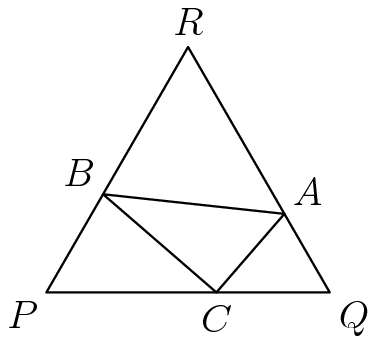Quite the same

Triangle A B C is inscribed in equilateral triangle P Q R . If P C = 3 , B P = C Q = 2 , and angle A C B = 9 0 ∘ , then compute A Q .
This section requires Javascript.
You are seeing this because something didn't load right. We suggest you, (a) try
refreshing the page, (b) enabling javascript if it is disabled on your browser and,
finally, (c)
loading the
non-javascript version of this page
. We're sorry about the hassle.
2 solutions
Moderator note:
There's a much simpler approach.
Because △ P Q R is an equilateral triangle, ∠ R = ∠ P = ∠ Q = 6 0 ∘ . Labeling x = A R , so A Q = 5 − x . Then by Cosine Rule , we can find the length of B C , A B , A C . By Pythagorean Theorem , B C 2 + A C 2 = A B 2 . Can you carry on from here?
B C = 2 2 + 3 2 − 2 ∗ 3 ∗ 2 ∗ ( 1 / 2 ) s i n ( ∠ P C B ) P B = s i n ( ∠ B P C ) B C ∠ B C P = a s i n ( 0 . 6 5 4 ) → ∠ A C Q = 9 0 − ∠ B C P → ∠ C A Q = 1 2 0 − ∠ A C Q s i n ( ∠ A C Q ) A Q = s i n ( ∠ C A Q ) C Q A Q = 5 8
Since △ P Q R is an equilateral triangle, we have R Q = P Q = P C + C Q = 3 + 2 = 5 . Let A R = x . By cosine rule, we have:
⎩ ⎪ ⎨ ⎪ ⎧ A B 2 = B R 2 + A R 2 − 2 B R ˙ A R cos 6 0 ∘ = 3 2 + x 2 − 3 x B C 2 = B P 2 + P C 2 − 2 B P ˙ P C cos 6 0 ∘ = 2 2 + 3 2 − 2 ( 3 ) A C 2 = A Q 2 + C Q 2 − 2 A Q ˙ C Q cos 6 0 ∘ = ( 5 − x ) 2 + 2 2 − 2 ( 5 − x ) = x 2 − 3 x + 9 = 7 = x 2 − 8 x + 1 9
By Pythagorean theorem, we have B C 2 + A C 2 = A B 2 :
x 2 − 3 x + 9 ⇒ 5 x x ⇒ A Q = 7 + x 2 − 8 x + 1 9 = 1 7 = 5 1 7 = 5 − x = 5 − 5 1 7 = 5 8